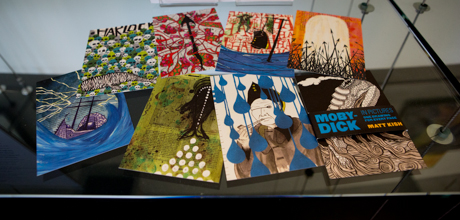“After Melville and Whitman: Contemporary Responses to the Civil War,” displayed in the Luther W. Brady Art Gallery lobby cases in the School of Media and Public Affairs building, is a visual exploration of how artists interpret historic and modern warfare. The exhibit includes contemporary work inspired by Herman Melville and Walt Whitman—prolific writers living during the Civil War—and poems about combat written by local high school students.
The exhibit opened on April 9 and will run until July 5, with a reception featuring the artists on June 6. The subject goes hand-in-hand with “Melville and Whitman in Washington: The Civil War Years and After,” a symposium co-sponsored by several GW departments, the Melville Society, Washington Friends of Walt Whitman and others that will take place on June 4.
“The Civil War was an overwhelmingly distressing time period in the U.S. because there was no guarantee the country would get back together,” said Olivia Kohler-Maga, assistant director of the Brady Gallery. “A lot of artists, especially during World War II, have gone back to the work of Whitman and Melville because they’ve struck a chord.”
Ohio-based artist Matt Kish translated Melville’s masterpiece “Moby Dick” through illustration by creating one piece of art for every single page of the book, using paint, ink and collage elements. Four images were chosen from his 522-page project to be displayed alongside the work of Massachusetts art teacher Douglas Paisley. Mr. Paisley used Melville’s 1857 novel “The Confidence Man” to create five paintings on plywood.
Photographs, paintings and journal entries offer a glimpse of Whitman living in D.C. during the late 1800s. His connection to the capital, Ms. Kohler-Maga said, is a unique opportunity to show the GW community what the city looked like during the Civil War. Pieces like the 1860s photograph “The Lone Bridge, 14th Street” from the George Washington University’s permanent collection add context to the exhibit.
“Whitman had such a great presence in D.C. during this time period,” Ms. Kohler-Maga said, explaining he originally came looking for his brother who’d gone missing during a battle and stayed for nearly the rest of his life. “This gives us a chance to talk about what D.C. was like back then, since the city really grew after the Civil War.”
Tying the whole exhibit together are several short poems interspersed throughout the cases. These were developed through a project of D.C. Miscellanea, a partnership between public high schools and GW’s Graduate School of Education and Human Development. Local poet Holly Bass led students from the SEED Public Charter School, Anacostia High School and School Without Walls through the halls of the Smithsonian American Art Museum’s “The Civil War and American Art” exhibit.
After browsing the art, Ms. Bass read poems by Melville, Whitman and Afghanistan veterans. Then, she gave the high schoolers directions: “Write a poem that is a portrait of war.” The resulting pieces depict all kinds of battles—fights between soldiers, conflicts in families and being at war with oneself.
“I go to war with my parent/every day it tastes Bitter/It feels like Nails poking/me At my nerves,” one student wrote in an untitled piece.
Ms. Kohler-Maga said she hopes the exhibit shows the impact of wars in modern day art.
“Although now we see the Civil War through black-and-white photos, we wanted to show it’s still relevant today,” she said.


